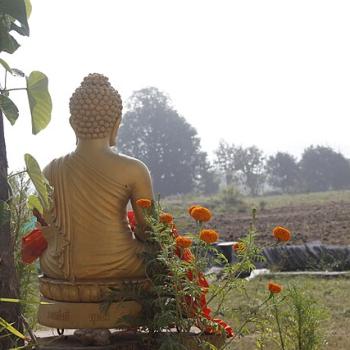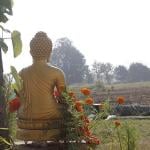The afternoon session at the Dharma teacher conference was much more successful than the morning program. Surya Das introduced a panel including Stephen Batchelor, Bhikkhu Bodhi, Sumi Loundon Kim and Spring Washam. They each spoke briefly. I would have been happy to hear any one of them go on for an hour. Instead they sparked a lively discussion about breadth and depth in our Western dharma.
I would love to see Bhikkhu Bodhi and Stephen Batchelor have at it sometime. Let me be clear. I would pay money to see them debate pretty much any aspect of the Buddhadharma…
The later afternoon session was a breakout according to traditions. As part of a relatively smaller contingent we Zendoids met with Thich Nhat Hanh folk, Won, Nicherin and Pure Land representatives. An interesting experience. Some old friends. Some tensions. Think family gathering…
Then just a bit ago Chozen Bays and I joined in a webcast, or maybe its a podcast discussing discrimination within the institutional Dharma led by Adam Tebbe of Sweeping Zen. I expect it’ll be posted before long…
I’m officially exhausted.
But, wait, there’s more! As a special treat for reading this far, here is Sumi’s reflection at the panel discussion.
Translation and Transmission of the Buddhadharma
by Sumi Loundon Kim
Not long ago I was watching a film about the Tibetan Book of the Dead with the
Buddhist students at Duke University, where I live and work. Much of the documentary follows the story of the death of one Ladakhi village elder, his family, and the local lama’s progression through the rituals prescribed in the Book. At some point, I stepped into an anthropologist’s perspective, watching the film as a cultural rather than spiritual exploration. And it suddenly struck me how incredibly and utterly foreign this practice is for those unfamiliar with Buddhism. If Evenz-Wentz hadn’t translated the text into English 84 years ago, making these rituals familiar to us today, we would find them, in truth, as far removed from our cultural framework as that of, say, the Hindu practice of suttee.
It was at that moment that I understood the immense gulf that, fifty or so years ago, lay between the traditional Buddhisms of Asia and Western spiritual aspirations. From that perspective, it is astonishing that not just the spark of the Dharma was somehow translated from East to West, but, if I could be so bold, the depth of Dharma was transmitted, as well. I don’t think we can underestimate the enormous challenge it was to take the deeply cultural Buddhisms of Asia and somehow make that accessible to the West. That was made possible by the outstretched hands of Asian teachers who themselves were thought of as modernizers and reformers by their more traditional monastic peers and the curiosity and passion of Westerners willing to plunge themselves into seeing what, in this religion, could be useful to their spiritual path.
I have long stood in awe of the courage of my teachers and others in the baby Boomer generation. I try to remember that in their time Buddhism was extremely fringy and that as they received profound teachings they had to grapple with enormous cultural issues around authority, the place of women, power, hierarchy, sexuality and more. In that regard, those of us born after the baby boomers should bear this in mind when we are critical of the elder generation’s missteps, confusion, and incomplete efforts. And given that the type of Buddhism came by way of monastics, for the most part, is it any wonder that the initial scope of Buddhism in the West was rather monastic-like, with the main type of community being the retreat center?
So, after this initial great and stunning translation, what next? We are beginning to see a tremendous diversification of models of teaching, of community, of styles of practice, of creative exploration, and even of the very definition of Buddhism. These experiments are being carried out by both the first generation as well as those of us following in their footsteps. Today there are those of us working with prisoners, the dying, the homeless, on suicide hotlines, with refugees, with marginalized groups in other countries; teaching in the medical world, in public schools, at yoga centers, in universities, with corporations, in the tech world; and creating connections between
Buddhist teachings and the environment, social justice, art, music, pop culture, alcoholism, eating disorders, Christianity, social media, and of course, motorcycle maintenance.
In the preconference meeting, the younger generation of teachers presented three statements to the older generation. One of these expresses beautifully, I think, what’s to come:
And in the spirit of gratitude and responsibility, and following in your pioneering spirit, we will transform the Dharma. In outward expression the way we teach may not look like yours; yet we will be continually working in our teaching to honor the deepest truth of the buddhadharma.
I don’t know if you’ve heard of the term “the Pizza Effect.” For those of you in academia, it’s more properly known as the hermeneutical feedback loop. The idea here is that somehow Italian cuisine was reinterpreted by Americans and then exported back to Italy such that, if you’re in Rome today you just might come across the American chains Domino’s Pizza or Pizza Hut. It might surprise you to hear that Buddhism is having it’s own Pizza Effect – and I don’t mean this in a demeaning way. That is, the translations of Buddhism in the West are now being introduced back to Asia, and these exports are having a noticeable impact on changing the way Buddhism is done there.
A wonderful article was recently published by a Korean monk who is also a professor of Buddhism at Hampshire College.
The title is: Countercurrents from the West: “Blue-Eyed” Zen Masters, Vipassanā Meditation, and Buddhist Psychotherapy in Contemporary Korea
And here’s what he says:
One surprising and yet relatively unknown aspect of contemporary Korean Buddhism is the significant influence of American and European Buddhism. Between 1989 and 2009, South Koreans witnessed well-educated “blue-eyed” monastic residents via the Korean media, and the emergence of new bestsellers by authors like Thich Nhat Hahn and Jack Kornfield, written initially for Western audiences but since translated into Korean. The new teachings from the West have inspired a sudden growth of interest in vipassanā meditation as an “alternative” to Kanhwa Sŏn practice, and the emergence of a new academic field: Buddhist psychotherapy. This new wave of transnational influence from the West has changed not only the way Koreans practice Buddhism but also how they perceive Buddhist history and their own identities. In addition, the perceived “prestige” of Buddhism in the West has provided a new rhetorical strategy to defend Buddhism against other religions, particularly Korean evangelical Christianity.
Fascinating, isn’t it? So when we think about the breadth of Buddhism in the West, we really now must think globally, that the work we’re doing here has far-reaching implications. And, I wouldn’t be surprised if twenty years from now a new form of Korean-vipassana-psychotherapy somehow comes back to the shores of other countries. We are entering a whole new era in Buddhism, a new translation and transmission that offer tremendous promise and accessibility to a great diversity of people.













